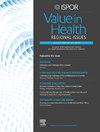Cost-Utility Analysis and Efficiency Frontier of Drugs Available in Brazil for the Treatment of Relapsing-Remitting Multiple Sclerosis
IF 1.4
Q3 HEALTH CARE SCIENCES & SERVICES
引用次数: 0
Abstract
Objectives
In the Brazilian Public Health System (SUS), the different drugs for the treatment of relapsing-remitting multiple sclerosis (RRMS) are used in an escalating approach, through therapeutic lines from lowest to highest efficacy. Early intensive treatment, indicating the use of more effective drugs for the first symptoms of the disease, has been advocated by some specialists; however, the clinical and economic impact of this strategy is unknown. The aim of this study was to conduct cost-utility, net benefit, and efficiency frontier (EF) analyses for all drugs approved in Brazil for RRMS.
Methods
A Markov model was constructed from the SUS perspective to conduct economic analyses. The outcomes of the annualized relapse rate and sustained disability progression were modeled, considering disease progression according to changes in levels on the Expanded Disability Status Scale. Net benefit and EF analyses were also conducted.
Results
In the cost-utility assessment, 12 of the 14 drugs were dominated by alemtuzumab and teriflunomide. An EF was established between the 2 drugs with an incremental cost-effectiveness ratio of $8231.87/quality-adjusted life-years. Teriflunomide obtained the best results in the net benefit assessment. Most drugs had an incremental cost-effectiveness ratio below the cost-utility threshold ($8000.00/quality-adjusted life-years) in the probabilistic sensitivity analysis.
Conclusions
Early intensive treatment of EF may modify the current RRMS treatment paradigm, and the results presented may help define the cost utility of new entrants to the SUS.
巴西治疗复发-缓解型多发性硬化症可用药物的成本-效用分析和效率前沿
目的 在巴西公共卫生系统(SUS)中,治疗复发性-缓解性多发性硬化症(RRMS)的不同药物是按照疗效从低到高的治疗路线逐步升级使用的。一些专家提倡早期强化治疗,即在疾病出现最初症状时使用更有效的药物;然而,这一策略对临床和经济的影响尚不清楚。本研究旨在对巴西批准的所有治疗 RRMS 的药物进行成本效用、净效益和效率前沿(EF)分析。根据残疾状况扩展量表(Expanded Disability Status Scale)水平的变化考虑疾病进展,对年复发率和持续残疾进展结果进行建模。结果在成本效用评估中,14 种药物中有 12 种以阿来珠单抗和特立氟胺为主。这两种药物的增量成本效益比为 8231.87 美元/质量调整生命年,确立了 EF。特立氟胺在净效益评估中获得了最佳结果。在概率敏感性分析中,大多数药物的增量成本效益比都低于成本效用阈值(8000.00美元/质量调整生命年)。结论早期强化治疗EF可能会改变目前的RRMS治疗模式,所提供的结果可能有助于确定新加入SUS的药物的成本效用。
本文章由计算机程序翻译,如有差异,请以英文原文为准。
求助全文
约1分钟内获得全文
求助全文
来源期刊

Value in health regional issues
Pharmacology, Toxicology and Pharmaceutics-Pharmacology, Toxicology and Pharmaceutics (miscellaneous)
CiteScore
2.60
自引率
5.00%
发文量
127
 求助内容:
求助内容: 应助结果提醒方式:
应助结果提醒方式:


